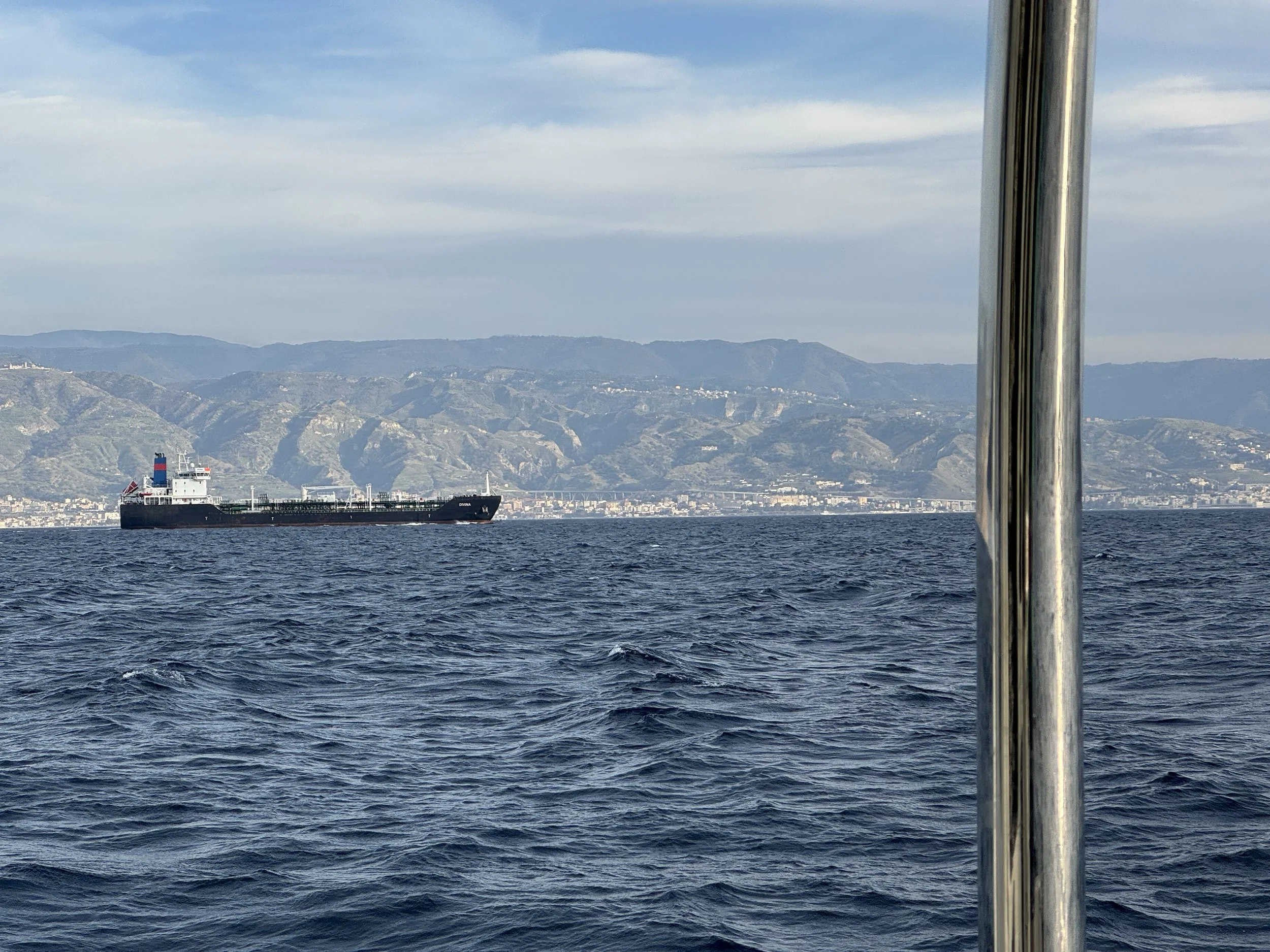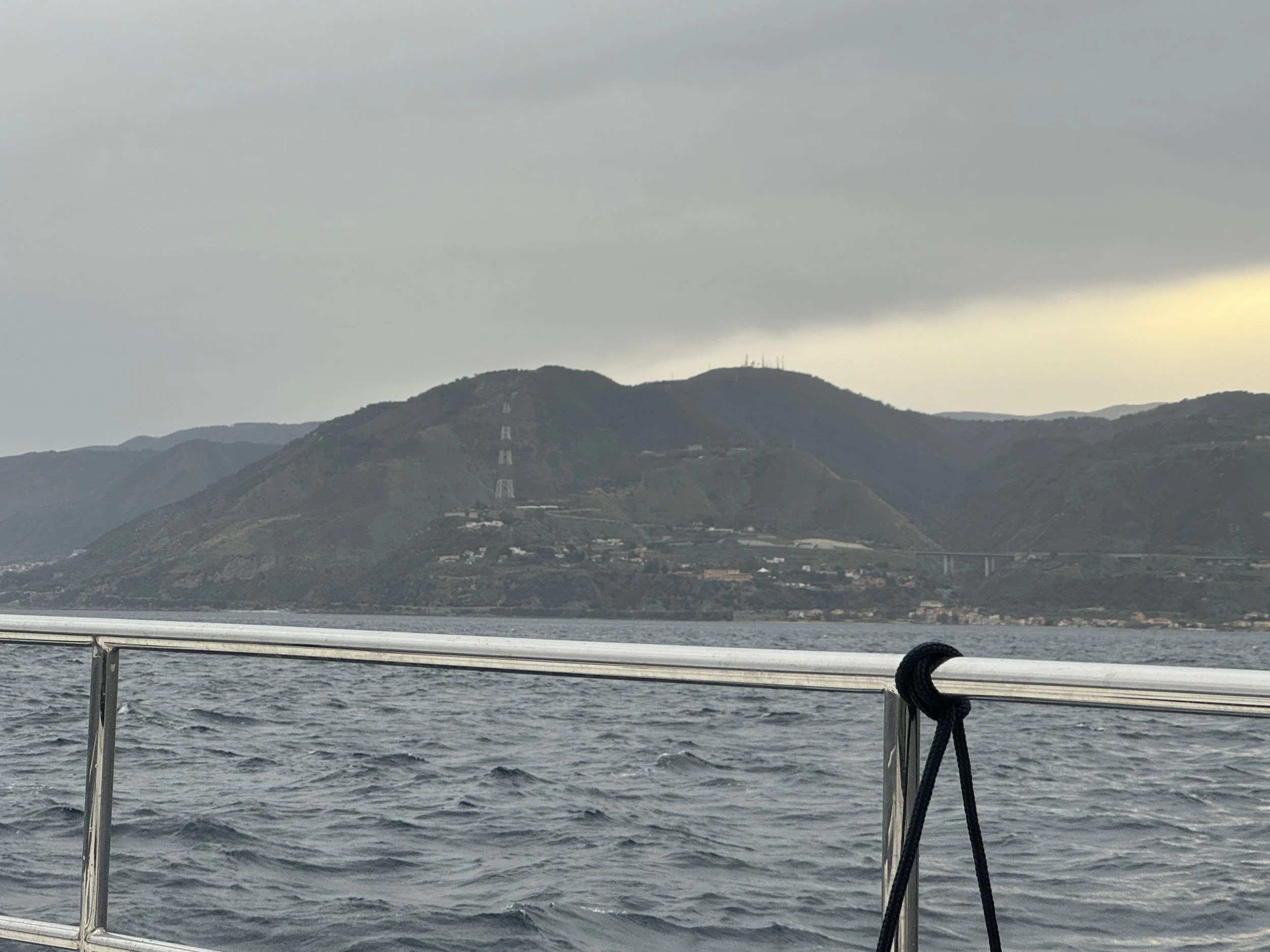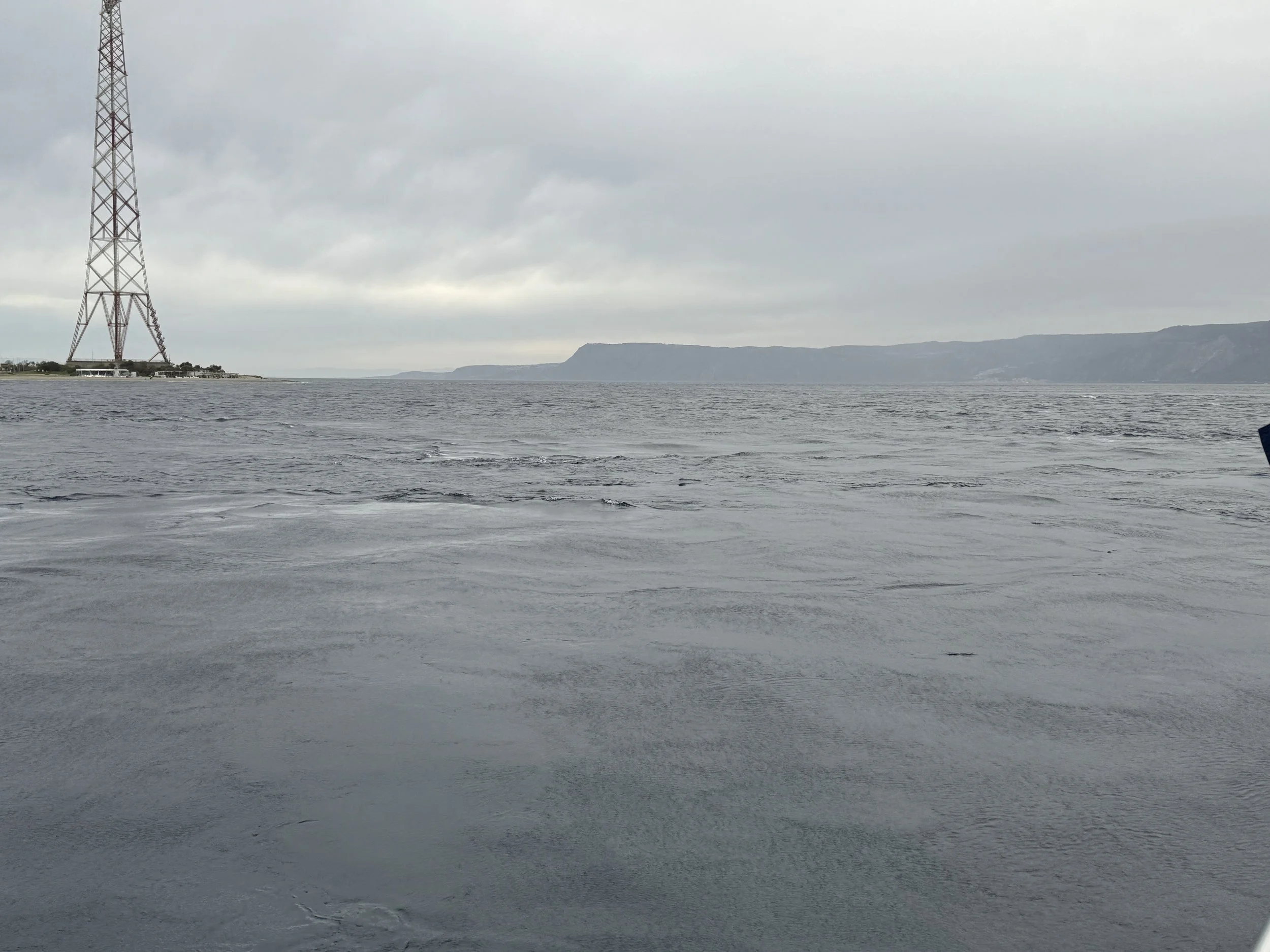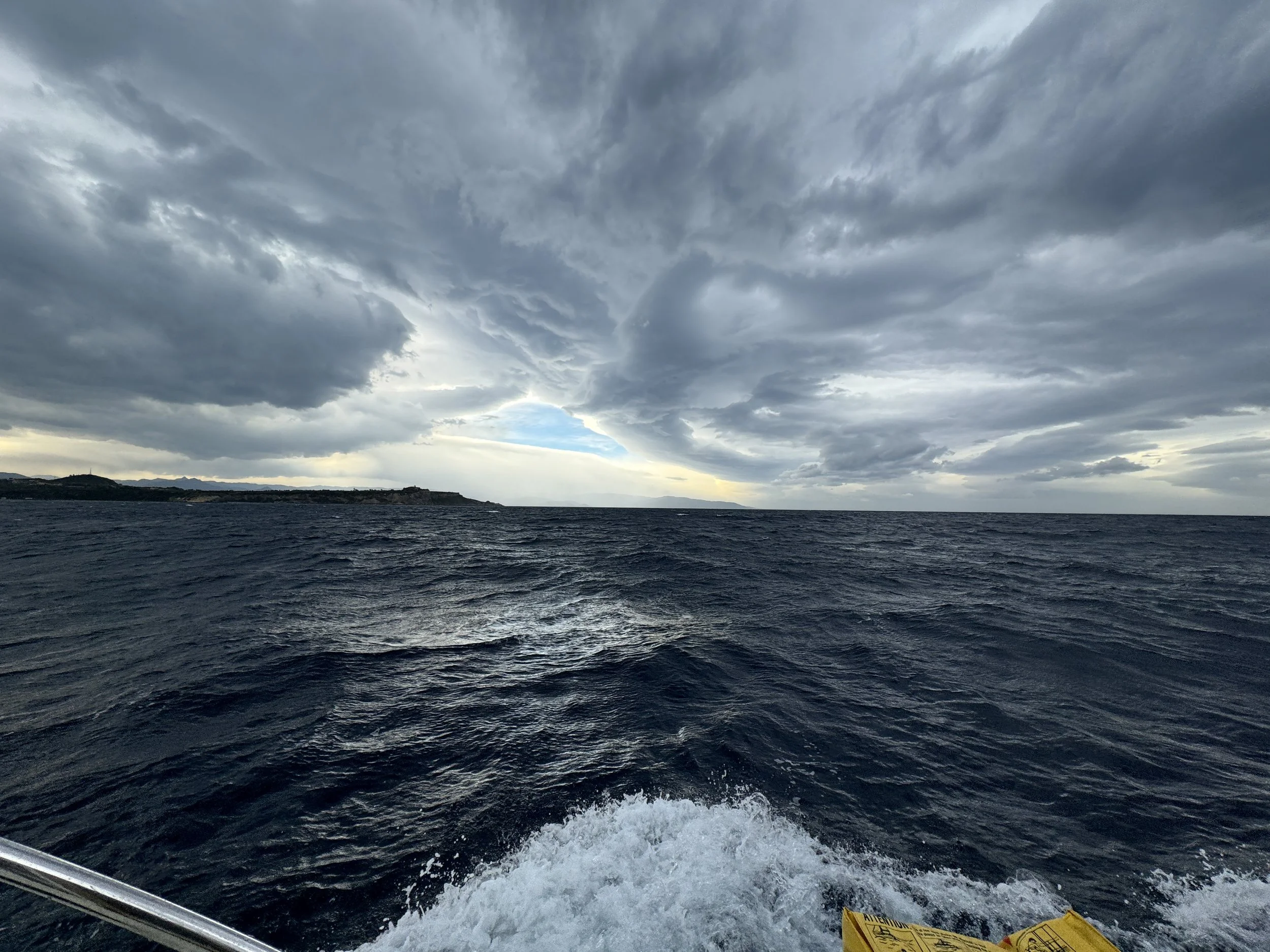Best Laid Plans & Bad Decisions
From Syracuse, Sicily cruising north you pass through the Strait of Messina. This is notoriously a tricky passage. This narrow channel lies between the eastern tip of Sicily (Punta del Faro) and the western tip of Calabria (Punta Pezzo) in Southern Italy. The Strait joins the Tyrrhenian Sea in the north with the Ionian Sea in the south and has a reputation for its hydrological peculiarities – namely whirlpools, strong changeable currents and internal waves. At the speed we travel we could not transit the entire strait before the current reversed. We could either begin with the current with us and have it reverse before we made it through, or vice versa. I’m not going to lie, this passage was worrying me.
Furthermore, the Strait is divided into two shipping "lanes" by a virtual "centerline" (the pink line on the map). Large vessels moving south are required to keep west of this line, and to navigate closer to Sicily. Those that are moving north must keep east of that line and navigate closer to Calabria. The only way to cross from side to side is to turn counterclockwise around the "roundabout" (the pink circle on the map). Little boats like us must stay by the shore and completely out of those shipping lanes. In addition to all the commercial vessels, there are dozens of large ferries zipping across the Strait between Messina and the mainland around the clock.
We needed to get from Syracuse in southern Sicily, up through the Strait and into a protected harbor or marina before the oncoming storms or we would be spending an additional week, or more likely two, where we were.
Syracuse to Messina would take us a full day of cruising. There were not many options for stopping in between. The marina in Messina had space for us, though because of the winds, currents, commercial dock and constant ferry traffic, it is not considered a calm one and is primarily used as a brief stopover by smaller yachts. Assuming we could find the right weather window that’s what we would do - an overnight in a less than perfect marina would be fine.
The forecast showed a favorable two-day weather window. We would cruise to Messina the first day, overnight there, and the next morning transit the Strait and continue on to a marina in the Aeolian Islands which would be a terrific place to wait out the coming storms. The 11.5 hour cruise to Messina started before dawn with small choppy waves that smoothed out throughout the day. We arrived in the marina in Messina just before sundown. As expected, there was a lot of rocking and rolling through the night but we managed to sleep, and awoke early, rested and ready to face the Strait.


Side note: on either side of the Strait are what’s known as the Pylons of Messina. Once the power supply to all of Sicily, the overhead power-line had a span of over 3 kilometers (2 miles). The two pylons, one north of Messina in Sicily and one at Porticello on the mainland, were built in 1957. They are 232 meter (761 ft) high freestanding steel towers. Each pylon sits on an 8 meter (26 ft) tall cross-shaped base.
Because of the enormous span and the maritime traffic in the strait below, the electrical conductors needed to have sufficient minimum height above ground, and had to be constructed with tremendous tensile strength. This required the use of steel cables as conductors even though steel has the disadvantage of poorer electrical conductivity than normal aluminum overhead power lines.
The danger of oscillations caused by wind was also of great concern so the engineers at that time designed a way to test the strength of the structures and their maximum deflections. They mounted three rockets with a thrust of 9800 kilo-newtons on top of each pylon and ignited them! The towers must have passed the test because they remained in use until 1994 when the power-line no longer met the modern operational standards and was replaced by a sub-marine cable.



We had been checking the currents in the Strait repeatedly. Truthfully, we couldn’t determine exactly when the best time was to go. We never seemed to find agreement among the various sources of information; discussions with the marina folks, updates on the websites and consulting the weather - nothing to do but go for it! We had a grey, overcast morning with light rain when we headed out of the marina at sunrise. I stood on deck up in the bow looking for whirlpools. We had the current with us most of the way north which increased our speed by nearly 30%! There was a very brief moment of slack as the current reversed directions, and we cruised through a small whirlpool just afterwards which slowed our speed to a crawl, but we exited the Strait without any difficulty. Wow, that was wonderfully uneventful!




We continued on around the northeast corner of Sicily and pointed our nose northwest toward the Aeolian Islands. Just a few more hours and we would be tucked in for a week of exploring. Unexpectedly, this is where it got interesting. As we motored along we noticed unsettled weather to the west. Suddenly the wind increased from 25 to 40 knots and the waves grew to 2 meters (6.5 ft.) - hitting us on the beam. It got quite uncomfortable and we decided to turn around and tuck into a protected bay where we could wait for the squalls to pass. We turned south toward Sicily once again and cruised for most of an hour before finding a sheltered bay. We bobbed around there in the lee of a large point and waited. A little over an hour later, after two storm fronts passed overhead, the sky brightened and the winds died down so we headed out once again.
Bad weather approaching
As we came out from behind the point we noticed another front off in the distance but as the seas were so much calmer we weren’t worried about it, assuming we’d be nearing the islands before it arrived. Not even an hour later, about midway across, everything changed. The wind abruptly increased and began blowing 40-45 knots and then suddenly the seas were 3 meters (10 ft.) high and smashing us on the beam! Tom altered course westerly, turned off the autopilot and hand steered into each oncoming wave so we weren’t being broadsided. Once more we talked about turning back, but we still would have been broadside to the waves and we would have had to zig zag our way, adding both time and distance before reaching the sheltered bay. It seemed best to continue on, though we were still heading away from where we needed to go. Walls of water were pouring in through the vents in our salon windows each time a wave crashed onto the cabin sides. I darted down below to grab some towels to stop the flood. The boat tossed violently side to side and locked drawers in the galley flew open! I managed to find some strapping tape and secured the drawers as we shouldered on. We saw gusts of 58 knots flash on the nav screen - which is when I stopped looking. It seemed better if I didn’t know.
Six seconds of weather BEFORE the real storm hit!
After what seemed like forever the winds dropped a bit and the seas began to settle. The powerful front had passed by and Tom turned 90 degrees east, back in the direction we wanted to go. Immediately the ride became more comfortable, the waves now hitting us aft of the beam. Running with the stern toward the waves is always preferable. Even though we were only now down to 2 meter (6.5 ft) high waves, we breathed a little easier. It wasn’t until we got into the lee of Vulcano, the southern most Aeolian Island, that we were out of both the high winds and fierce waves.
The trauma actually only lasted about 30-40 minutes (which at the time seemed a lot longer). As we cruised more comfortably towards our destination I immediately began reviewing what we’d done wrong. I had seen the front off to the west. I had noticed the barometer falling. I knew there was unsettled weather. For crying out loud, I have a degree in atmospheric physics - why hadn’t I paid more attention in meteorology class back in college! I had always hated forecasting (leaning more into the hard science than predictions) AND I was terrible at it! Why hadn’t I tried harder? Why hadn’t I studied the differences between weather over land masses and that of the ocean - BEFORE moving aboard?
I dwelt on these questions for some time before I realized that, strangely, I had not felt the slightest bit seasick?!? And moreover, quite uncharacteristically, I had also not felt terrified?!? Oh it was frightening, without a doubt, but not as terrifying as some previous experiences I’d had aboard (see post from exactly one year ago: “Assimilating Fear”). Had I been too deeply involved in the moment to recognize what I was feeling? Maybe I’d been in shock, or was numb? Or, am I perhaps gaining some confidence in my ability to handle these adverse situations? As I examined more deeply exactly what I was feeling, one realization arose. I, unequivocally, feel quite safe on our little boat. Yes, there is always the possibility of us screwing up and we clearly made some bad decisions, but I never once questioned our boat failing. I felt completely assured of her ability to handle the weather we were in. Meraki is a mighty little ship…and I am so very grateful on so many levels!
Despite this completely unexpected ordeal, we surprisingly still arrived in our marina on the Island of Lipari before sundown. Snug in our berth, I cooked some comfort food for dinner and we spent a quiet evening reviewing what we should have done, what we would do differently should that ever happen again, and the many things that we still need to learn. But slowly, as the calm settled in, we also commended ourselves for meeting the challenge with what was required - focused attention and teamwork. We can’t control all the conditions of our life, but we can choose how we respond to them. And I find solace in the knowing that I am learning and growing. We drank a glass of scotch, and heading off to bed. Tomorrow was another day.
Note: Not all of the photo captions will appear if viewing on a cell phone.






